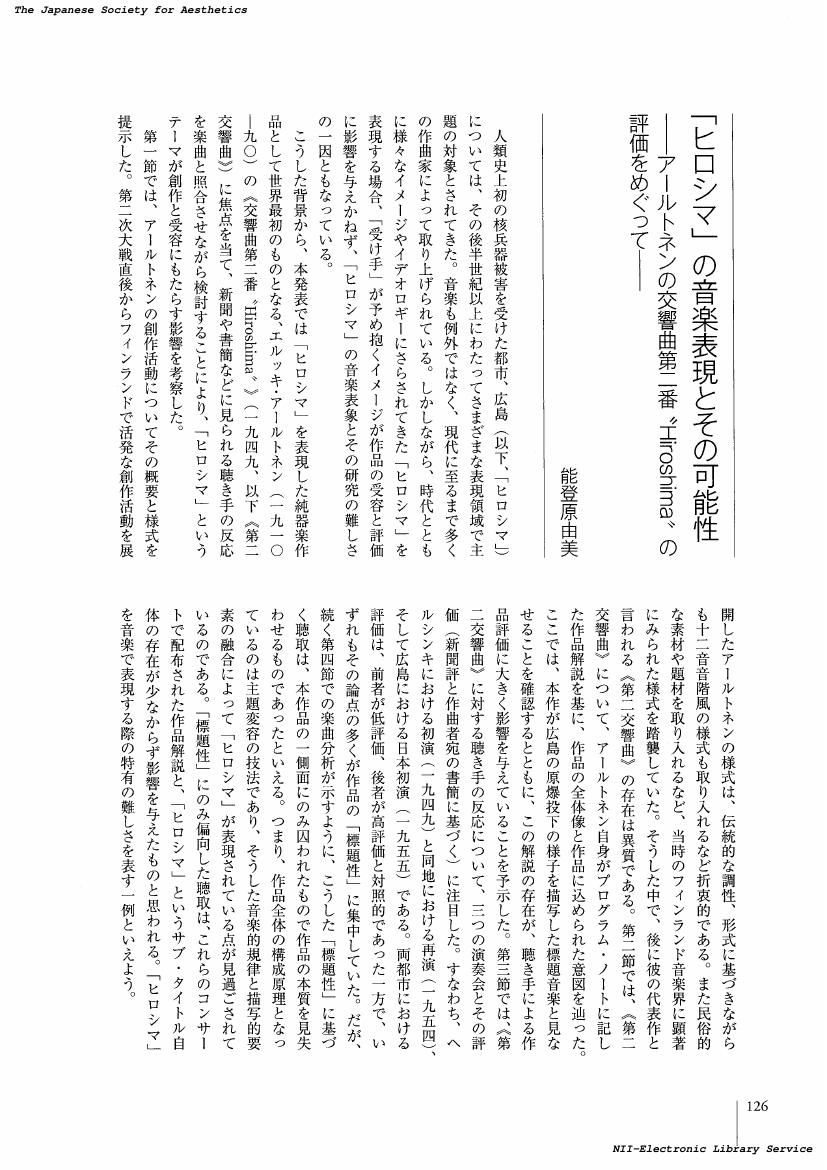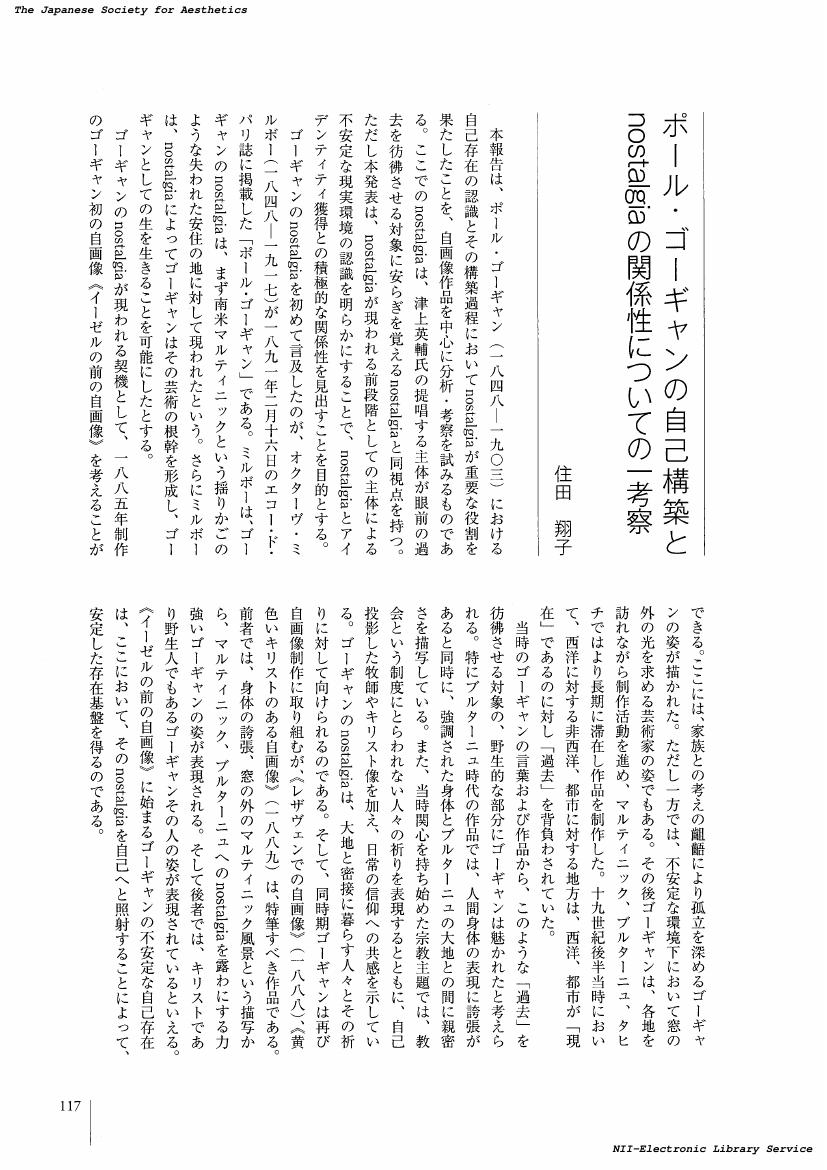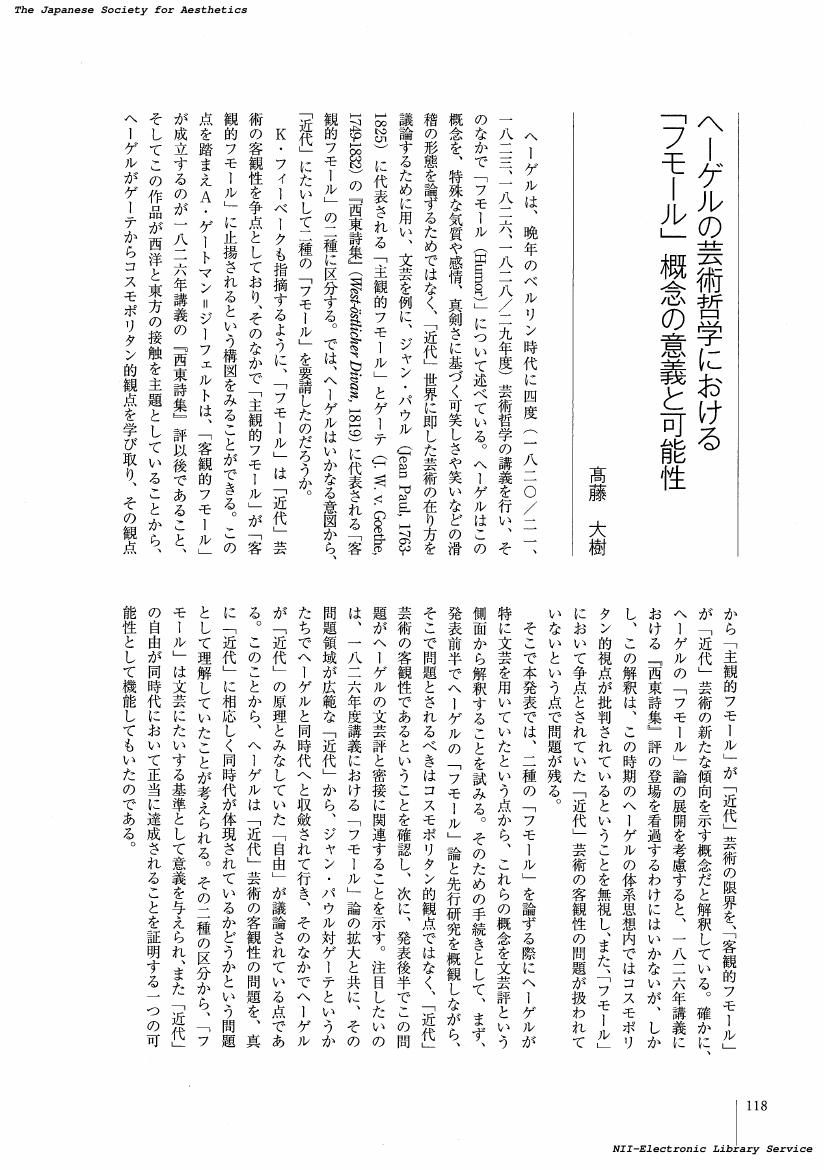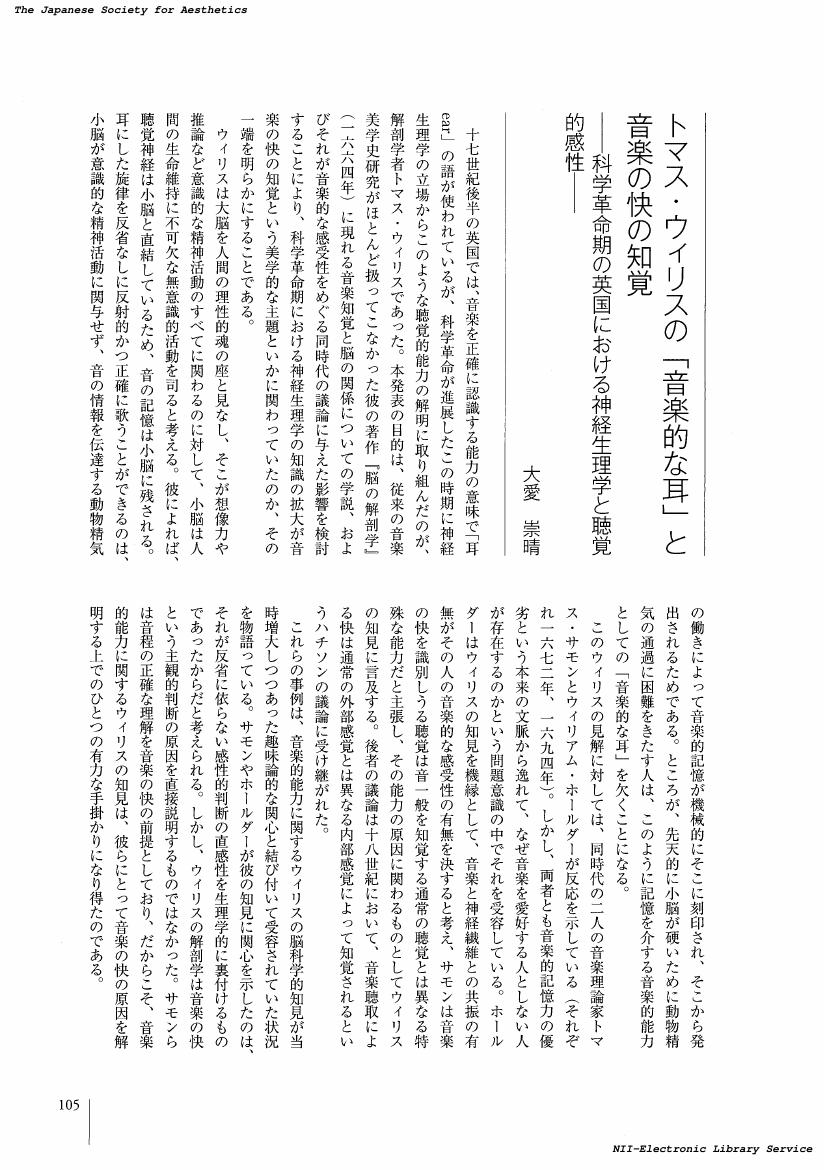- 著者
- 利根川 由奈
- 出版者
- 美学会
- 雑誌
- 美学 (ISSN:05200962)
- 巻号頁・発行日
- vol.62, no.2, pp.123, 2011-12-31 (Released:2017-05-22)
1 0 0 0 OA 「桜の樹の下には」における桜の美(第六十二回美学会全国大会発表要旨)
- 著者
- 長迫 英倫
- 出版者
- 美学会
- 雑誌
- 美学 (ISSN:05200962)
- 巻号頁・発行日
- vol.62, no.2, pp.124, 2011-12-31 (Released:2017-05-22)
- 著者
- 新倉 慎右
- 出版者
- 美学会
- 雑誌
- 美学 (ISSN:05200962)
- 巻号頁・発行日
- vol.62, no.2, pp.125, 2011-12-31 (Released:2017-05-22)
- 著者
- 能登原 由美
- 出版者
- 美学会
- 雑誌
- 美学 (ISSN:05200962)
- 巻号頁・発行日
- vol.62, no.2, pp.126, 2011-12-31 (Released:2017-05-22)
- 著者
- 岸本 督司
- 出版者
- 美学会
- 雑誌
- 美学 (ISSN:05200962)
- 巻号頁・発行日
- vol.62, no.2, pp.111, 2011-12-31 (Released:2017-05-22)
- 著者
- 桑原 俊介
- 出版者
- 美学会
- 雑誌
- 美学 (ISSN:05200962)
- 巻号頁・発行日
- vol.62, no.2, pp.112, 2011-12-31 (Released:2017-05-22)
- 著者
- 坂田 道生
- 出版者
- 美学会
- 雑誌
- 美学 (ISSN:05200962)
- 巻号頁・発行日
- vol.62, no.2, pp.113, 2011-12-31 (Released:2017-05-22)
- 著者
- 佐々木 千佳
- 出版者
- 美学会
- 雑誌
- 美学 (ISSN:05200962)
- 巻号頁・発行日
- vol.62, no.2, pp.114, 2011-12-31 (Released:2017-05-22)
- 著者
- 嶋田 久美
- 出版者
- 美学会
- 雑誌
- 美学 (ISSN:05200962)
- 巻号頁・発行日
- vol.62, no.2, pp.115, 2011-12-31 (Released:2017-05-22)
1 0 0 0 OA W・G・ゼーバルト『空襲と文学』における廃墟の位相(第六十二回美学会全国大会発表要旨)
- 著者
- 鈴木 賢子
- 出版者
- 美学会
- 雑誌
- 美学 (ISSN:05200962)
- 巻号頁・発行日
- vol.62, no.2, pp.116, 2011-12-31 (Released:2017-05-22)
- 著者
- 住田 翔子
- 出版者
- 美学会
- 雑誌
- 美学 (ISSN:05200962)
- 巻号頁・発行日
- vol.62, no.2, pp.117, 2011-12-31 (Released:2017-05-22)
- 著者
- 高藤 大樹
- 出版者
- 美学会
- 雑誌
- 美学 (ISSN:05200962)
- 巻号頁・発行日
- vol.62, no.2, pp.118, 2011-12-31 (Released:2017-05-22)
- 著者
- 大愛 崇晴
- 出版者
- 美学会
- 雑誌
- 美学 (ISSN:05200962)
- 巻号頁・発行日
- vol.62, no.2, pp.105, 2011-12-31 (Released:2017-05-22)
- 著者
- 大熊 洋行
- 出版者
- 美学会
- 雑誌
- 美学 (ISSN:05200962)
- 巻号頁・発行日
- vol.62, no.2, pp.106, 2011-12-31 (Released:2017-05-22)
- 著者
- 小河原 あや
- 出版者
- 美学会
- 雑誌
- 美学 (ISSN:05200962)
- 巻号頁・発行日
- vol.62, no.2, pp.108, 2011-12-31 (Released:2017-05-22)
1 0 0 0 OA 美と健康の接近 : フランス新印象派と<民間療法>(第六十二回美学会全国大会発表要旨)
- 著者
- 加藤 有希子
- 出版者
- 美学会
- 雑誌
- 美学 (ISSN:05200962)
- 巻号頁・発行日
- vol.62, no.2, pp.109, 2011-12-31 (Released:2017-05-22)
1 0 0 0 OA 人形浄瑠璃における「情」の重視と三人遣い操法の成立
- 著者
- 細田 明宏
- 出版者
- 美学会
- 雑誌
- 美学 (ISSN:05200962)
- 巻号頁・発行日
- vol.62, no.2, pp.37-48, 2011-12-31 (Released:2017-05-22)
In Bunraku, a single puppet is manipulated by three puppeteers. In this paper, we will consider the method of operating Bunraku puppets by referring to the theory of the Joruri narrative because Bunraku is formed by uniting Joruri and puppets. In the 17th century, special puppeteers, Tezuma ningyotsukai, appeared and showed off their clever techniques. Bunraku puppeteers, under the influence of them, wanted to manipulate finer movements and needed two assistants as co-operators. Thus, the manipulation method of Bunraku puppets was established in 1734. Furthermore, the mechanism inside of the Bunraku puppet head was made for richer expression of emotion; these mechanisms were used to show the puppeteer's technique in Tezuma puppets. Actually at that time, there was a significant change in the artistic theory of Joruri. From that point, the importance of expressing the feelings of the characters has been established. There is a similar claim written later in the theoretical book about how to operate the Bunraku puppets. In brief, the operation method of Bunraku puppets was established for expressing the character's feelings, in accordance with the artistic theory of Joruri.
1 0 0 0 OA 読書のルネサンス史 : 印刷術以後の人文主義にみる認識行為の変容
- 著者
- 田中 佳佑
- 出版者
- 美学会
- 雑誌
- 美学 (ISSN:05200962)
- 巻号頁・発行日
- vol.62, no.2, pp.49-60, 2011-12-31 (Released:2017-05-22)
It is a familiar fact that the printed books wiped out the manuscripts in the late 15th century European intellectual world. However, the significance of it in the historical context is too complex to interpret as a mere technical invention. In the present paper I shall try to explain, though only in philological way, what sort of directions were given in the Renaissance humanism by printing and the printed books as the problem of the history of ideas. I shall not discuss the mode or artistic format of any incunabula and early printed books, mine is rather abstract task of trying to understand, through some documents of Italian humanists, the historical impact of printing on the Renaissance era. My aim will accordingly indicate the essential correlation of printing with the Modern form of knowledge. In my idea, printing has three aspects: (i) the institutional package which produced the public value of books by means of mass circulation, (ii) the product of a certain technologism which changed knowing as personal study into knowing as impersonal manipulation, (iii) the breaker of the traditional close relationship between the authors and the readers. One may find these aspects support our form of knowledge.
- 著者
- 田口 かおり
- 出版者
- 美学会
- 雑誌
- 美学 (ISSN:05200962)
- 巻号頁・発行日
- vol.62, no.2, pp.61-72, 2011-12-31 (Released:2017-05-22)
Cesare Brandi (1906-1988) wrote The Theory of Restoration in 1966 as an integral part of his general conception of art and there he identified the purpose and duty of restoration, which had not been fully developed in previous centuries. This research focuses on his specific theory of the reintegration of the lacunae. Brandi did not agree to a traditional method, restoring the original appearance of art by using the almost identical technique to an artist, which could end up producing a counterfeit. As an alternative, Brandi proposed the reintegration with neutral colour, in which the lacunae would be filled up with moderate colours somewhere between grey and ocher. Although quite a few restorers adopted his unique method, it gradually came to be considered inappropriate for its peculiar appearance so that it almost disappeared by the end of seventies. Slighted as a short-lived proposal, neither a true significance of an intervention with neutral colour nor Brandi's intention on this has been deeply argued. This paper treats the reintegration with neutral colour as an embodiment of Brandi's idea on respecting "time in relation to the art", and it will verify how Brandi's theory and that of his contemporaries correspond to the method of neutral colour.
- 著者
- 秋吉 康晴
- 出版者
- 美学会
- 雑誌
- 美学 (ISSN:05200962)
- 巻号頁・発行日
- vol.62, no.2, pp.102, 2011-12-31 (Released:2017-05-22)
















